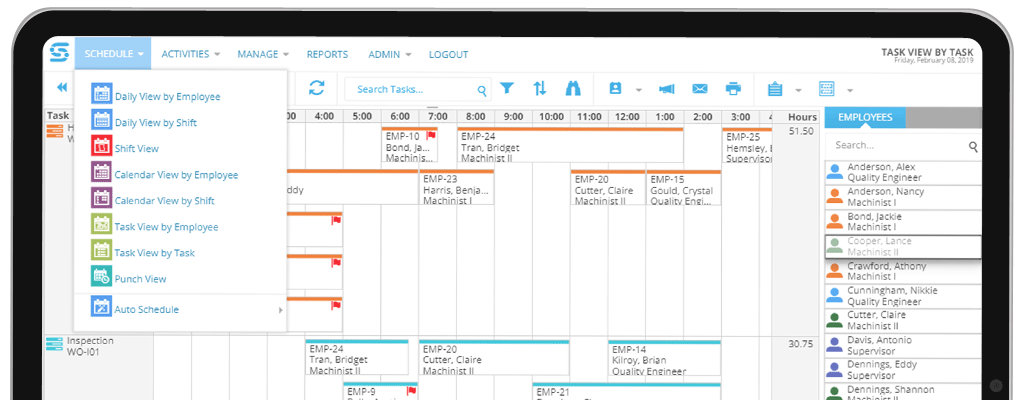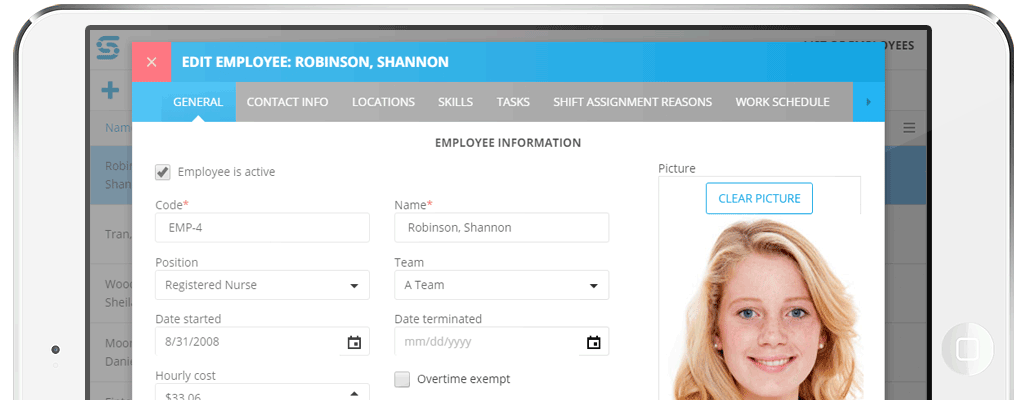Snap Schedule 365
Complete Employee Scheduling Features For THE Modern Workforce
From scheduling to employee self-service, Snap Schedule 365 gives you 24/7 access to innovative features that save time, reduce labor costs, improve productivity and promote employees’ work-life balance.
Swipe, tap, or click. Snap Schedule 365’s modern UI lets schedulers and managers easily manage their workforce anywhere and anytime, on any device. Its powerful features cover every aspect of modern day workforce management. Available 24/7 and accessible to employees whether at work or at home, Snap Schedule 365’s self-service features cut scheduling and administrative time by making employees more pro-active in the process.
Scheduling

Create schedules for a virtually unlimited number of employees, shifts, and tasks in multiple views. The Daily view shows all shifts and time off for each employee in a specified date range. The Shift view shows employee staffing for each shift along with coverage data. The Task view lets you schedule tasks and breaks within a shift. The Calendar view presents work and time off assignments in calendar format.
Define as many locations/departments as you like and authorize your employees to work at specific locations. Schedule your employees for shifts at one or several locations. Filter/sort work schedules and reports based on locations. Schedule multiple teams across jobsite with ease.
For shift systems with repeatable shift patterns, auto-generate each team member’s shift assignments for any scheduling period.
Within a shift assignment, you can schedule and specify which tasks (duties) an employee will perform or when an employee can take breaks.
Easily find qualified and eligible employees to fill open shifts based on availability, position, skill, labor cost, work hour limits, seniority and other criteria.
View in real time employees’ punch in/out times in a graphical format or in list forms. See tardy employees and how scheduled shifts and hours compare to the actual shifts and hours. Eliminate early punch in or late punch out by specifying a time window when employees can punch in/out.
Keep an audit trail and maintain complete control over the scheduling process by setting up multiple schedulers with different responsibilities. Allow schedulers to create/change employees’ schedules, approve time-off and open shift requests, update employees’ cost data, run reports, and much more. Each scheduler is associated with a role that defines the commands and features that the scheduler can perform.
Complex shift assignments, such as split shifts, multiple shifts, paid/unpaid time off, and on-calls, are all supported. Easily drag-and-drop or use the context-sensitive menu to assign shifts or make schedule changes without having to enter/type in the information.
Plan various shift patterns and develop “what-if” scenarios to better meet the demands of your business. Then auto-generate shift schedules from the best shift pattern. Easily model and generate any fixed, oscillating, staggered, mixed, and rotating shift schedule.
Detect conflicts like overlapping shifts, lacking required skills, minimum rest period, or too many overtime hours. Any conflicts will be clearly flagged and color-coded on schedule views.
Show the number of employees scheduled in each shift by position, skill, or reason so you can quickly see if any position is over/under staffed while making shift assignments.
Shift assignment reasons provide additional details and explanations and can be used to group and filter assignments.
Print, post, email, and export schedules in a variety of formats. Employees can view their schedules online, request time off, bid on open shifts, trade/pick up shifts, punch in/out, update availability and more from any computer, tablet, or mobile device. Keep your team in the loop and find last-minute substitutes quickly with multiple easy ways to post schedules and communicate changes, including email and in-app notifications.
Set roles to limit access to sensitive data. You can create as many roles as you like, each with a different set of privileges, and assign a role to a group of schedulers. For example, you can create a Scheduler role with the authority to create and update schedules; an Administrator role that allows full access to schedules, personnel data, and manpower requirements; and a Supervisor role with only read access to certain schedule views and reports.
EMPLOYEE ACCESS & SELF-SERVICE
From home to business, from desktop to mobile devices, your employees can have 24/7 access to schedule data. You control who will be allowed access and which features will be enabled for your operations.
Empower your employees by letting them self-schedule with open shifts. Schedulers simply create an open shift for a position and specify the number of employees needed and the required skills. Qualified employees view open shifts and bid for the shift they like. Schedulers then approve or reject the bid and the employee will be alerted of the approval status via email, in-app notification, or both.
You can set up Snap Schedule 365 to allow shift trading between employees with or without a scheduler’s approval. Employees can post their assigned shifts to trade with coworkers who are eligible to work the shifts. An employee posting the shift can select people from the list of qualified co-workers to invite bids. Invited co-workers can submit bids to just pick up the shift or to swap it with one of their assigned shifts. The posting employee can accept a bid but if scheduler approval is required, the trade will not be final until a scheduler approves it. Once finalized, Snap Schedule 365 instantly alerts the affected employees and automatically updates their schedules.
Save time and stay up-to-date by allowing employees to update their own contact information and availability. Employees can enter their availability by day and time segments. Snap Schedule 365 uses this information to help schedulers select available employees to fill shifts, find substitute employees, and report schedule conflicts.
Employees can look up coworker’s contact information to call, text, or email. Schedulers decide whom to include or exclude from the directory.
The monthly calendar planner lets employees view at a glance, their own shift assignments, time-off, shift trades, as well as co-workers’ work schedules. From this planner, employees can filter what they want to see, request time off, bid on open shifts, and trade or pick up shifts from co-workers.
Employees can make time off/vacation requests, and schedulers can track, manage, approve, or deny those requests. Employees can see the approval status and are automatically alerted when their request is approved or rejected.
Employees can punch in and out of their assigned shifts, and you can set the time window for when they are allowed to punch in or out. Schedulers can see the punch data in real-time in the Punch view or run reports to see the variances between planned vs. actual work hours and costs for any date range.
Employees can view their planned and actual work hours for the current, previous, or next payroll cycle. On-call, overtime, paid and unpaid time-off hours are also presented.
Employees can view their own tasks and breaks as well as team members’.
AUTOMATED SHIFT CALLOUT
Accurately and quickly find and contact the right employees to fill open shifts, to meet emergent work demands, or to restore services.
Employees can specify their availability and how they want to receive and respond to callout and scheduling notifications, either via phone calls or SMS texting.
Stay compliant and incorporate changes to regulations, union contracts, collective bargaining agreement requirements, staffing rules, and other regulatory policies into callout rules.
No more looking up union agreements to come up with a call out list and calling available employees over and over until a match is found. Automatically generate a ranked list of qualified employees in accordance with union rules, collective bargaining agreements, and labor regulations.
Employees are able to receive and confirm or decline shifts through the telephone or by text message. All interactions are logged for audit purposes and provide visibility into when calls were placed and who accepted, declined, or did not answer.
No more phone calls and time wasted! Automated callouts reduce grievances by enforcing callout rules and equalizing overtime opportunities— bringing transparency to the process and improving productivity and work-life balance.
LABOR COST CONTROLS
Automatically sum up employees’ work hours and costs; calculate overtime, on-call, time off, and shift premium pays; and provide detailed cost reports, so you know instantly if you are on budget.
Handle practically all types of overtime pay through daily overtime rules and work period overtime rules. Specify how overtime pay is computed for work hours in excess of: (a) certain hours per workday, (b) certain hours per work period, or (c) a combination of both. Similarly, on-call compensation can be a fixed amount per shift, a fixed amount per hour, a percentage of the employee’s standard rate, or any combination of the three.
Flexible premium pay rules help you compute extra pay to employees working on public holidays, certain days or hours of the day, irregular shifts, etc. Premium pay can be a fixed amount per shift, a fixed amount per hour, a percentage of the employee’s standard rate, or any combination of the three, and can include overtime calculations.
Adjust a shift’s scheduled start and end times to reflect actual time worked and instantly see the revised hours and costs. Add notes and reasons to record or explain deviations and provide time card data for payroll.
Keep track of planned work hours and actual work hours. Run reports to see variances in employee planned vs. recorded work hours and costs for any date range. Generate timecards for payroll based on either planned or recorded work hours.
Avoid grievances and ensure compliance with collective bargaining agreements, HR policies, and labor and working time regulations. When filling an open shift, you can use multiple criteria to narrow down the number of eligible employees.
EMPLOYEE INFO

Teams are used to facilitate scheduling of groups of employees or to filter, sort, and organize employees for display and reporting purposes.
Define skills/certifications and associate them with employees. Receive alerts when an employee’s certifications are about to expire. Select employees to fill a shift based on the required skills and certifications. Allow employees to bid on open shifts if they have the needed skills.
Identify multiple positions/departments within your company to assign employees and instantly know how many people you have under/over scheduled on each shift, by position.
Maintain complete employee contact information, picture, position, hire date, labor rate, skills/certifications, and skill expiration dates.
Schedulers or employees can enter employee availability information for each day of the week, desired work hours, days and hours available to work, and restrictions that should be considered when creating and managing schedules.
Use the 25 customizable text fields, numeric fields, check boxes, and date fields to store additional information to fit your business needs. You can define the captions and data formats for the data fields you want to display on the employee record form.
REPORTS
Use a comprehensive set of over 60 reports to analyze your scheduling data; prepare records for day-to-day management and planning; and track employee activities, work assignments, labor costs, coverage, and time-offs.
You can save a report with its customized settings so you can quickly recall and run it at a later time. All customized report settings including the setups for filters, sort orders, header/footer, and date range remain intact but data will be refreshed when you run the saved report.
Filter, sort, and group report data in thousands of ways. Include or exclude specific information in your reports, drill-down for more details, and make changes to the report data.
All reports are viewable onscreen and exportable to Adobe Acrobat’s PDF format, Microsoft Word, or Microsoft Excel.
Ready to see Snap Schedule in action?
Our product specialists will customize a demo that addresses each challenge, question, and goal you have—all at your convenience.
